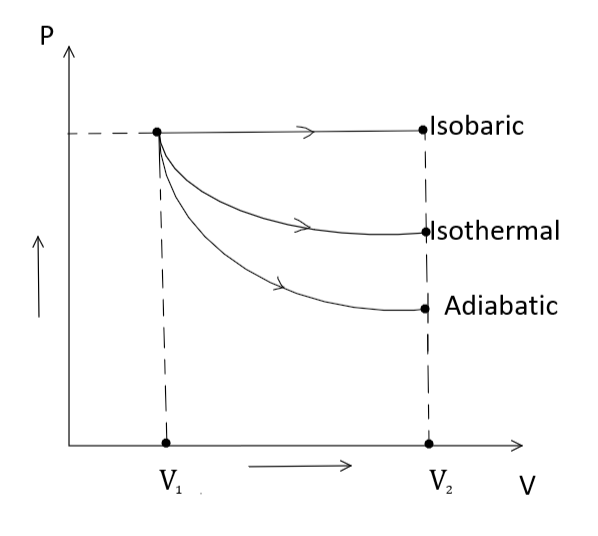
Which of the following is correct in terms of increasing work done for the same initial and final state?
A. $Adiabatic < Isothermal < Isobaric$
B. $Isobaric < Adiabatic < Isothermal$
C. $Adiabatic < Isobaric < Isothermal$
D. None of these
Answer
217.2k+ views
Hint: In this problem, to find out the correct order of work done in different processes such as isobaric, isothermal and adiabatic; we have to first analyze the conditions (such as pressure, temperature, heat) of given processes. Then, Plot a P-V graph as the area of the P-V graph is proportional to the work done.
Complete answer:
We know that for the Isobaric process, $P = $ constant
For the Isothermal process, $T = $ constant
and for the Adiabatic Process, there is no heat transfer i.e., $P{V^\gamma } = $ constant
Also, we know that in any thermodynamic process work done is always equal to the area covered by $P - V$ curve with the volume axis.
Let us draw $P - V$ graph of each of the given processes below: -

We can easily observe from the above graph that work done for all the three given processes i.e., Isobaric, Isothermal, and Adiabatic process is in the order:
${W_{Adiabatic}} < {W_{Isothermal}} < {W_{Isobaric}}$
Thus, the correct increasing order for work done is -$Adiabatic < Isothermal < Isobaric$. Hence, the correct option is (A) $Adiabatic < Isothermal < Isobaric$.
Note: Since this is a theoretically based problem, it is necessary to scientifically evaluate each and every option provided and plot a graph carefully for each isobaric, isothermal, and adiabatic process which will help in selecting an option that is more relevant and delivering the solution with proper explanation.
Complete answer:
We know that for the Isobaric process, $P = $ constant
For the Isothermal process, $T = $ constant
and for the Adiabatic Process, there is no heat transfer i.e., $P{V^\gamma } = $ constant
Also, we know that in any thermodynamic process work done is always equal to the area covered by $P - V$ curve with the volume axis.
Let us draw $P - V$ graph of each of the given processes below: -

We can easily observe from the above graph that work done for all the three given processes i.e., Isobaric, Isothermal, and Adiabatic process is in the order:
${W_{Adiabatic}} < {W_{Isothermal}} < {W_{Isobaric}}$
Thus, the correct increasing order for work done is -$Adiabatic < Isothermal < Isobaric$. Hence, the correct option is (A) $Adiabatic < Isothermal < Isobaric$.
Note: Since this is a theoretically based problem, it is necessary to scientifically evaluate each and every option provided and plot a graph carefully for each isobaric, isothermal, and adiabatic process which will help in selecting an option that is more relevant and delivering the solution with proper explanation.
Recently Updated Pages
Addition of Three Vectors: Methods & Examples

Addition of Vectors: Simple Guide for Students

Algebra Made Easy: Step-by-Step Guide for Students

Relations and Functions: Complete Guide for Students

Analytical Method of Vector Addition Explained Simply

Arithmetic, Geometric & Harmonic Progressions Explained

Trending doubts
JEE Main 2026: Application Form Open, Exam Dates, Syllabus, Eligibility & Question Papers

Derivation of Equation of Trajectory Explained for Students

Hybridisation in Chemistry – Concept, Types & Applications

Understanding the Angle of Deviation in a Prism

Understanding Collisions: Types and Examples for Students

How to Convert a Galvanometer into an Ammeter or Voltmeter

Other Pages
JEE Advanced Marks vs Ranks 2025: Understanding Category-wise Qualifying Marks and Previous Year Cut-offs

Units And Measurements Class 11 Physics Chapter 1 CBSE Notes - 2025-26

NCERT Solutions For Class 11 Physics Chapter 8 Mechanical Properties Of Solids

Motion in a Straight Line Class 11 Physics Chapter 2 CBSE Notes - 2025-26

NCERT Solutions for Class 11 Physics Chapter 7 Gravitation 2025-26

Understanding Atomic Structure for Beginners




